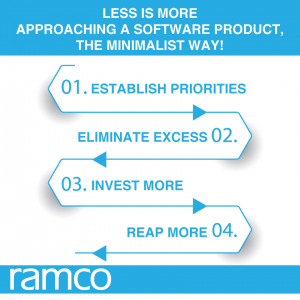
Less Is More. Approaching A Software Product, The Minimalist Way!
Published :

Some aimless googling on a Sunday afternoon introduced me to an interesting concept called ‘Minimalism’. Innumerable definitions appear on the screen to explain minimalism as a philosophy, religion, way of living.., in whatever way you want it. There are even checklists available to test if you are a minimalist -“If clutter makes you crazy, you might be a minimalist”, “If there are less than 33 things in your closet, you might be a minimalist”, “If you don’t have a junk drawer, you might be a minimalist”. To sum it all in a single sentence, Minimalism is a tool used to rid your own self of life’s excess, in favor of focusing on what’s important. In a minimalist’s words, it’s just living life the simple way.
In my way, this is how I understood MINIMALISM:
And, having worked in a software product company –developing features and supporting customers at times - for a year now, my mind automatically directs me into applying the concept to the product.
Establish Priorities
By developing an ERP product, we are in the business of providing a process framework for running the operations of our customer. In doing that, one of the biggest problems of all times is prioritizing what problem needs to be addressed. There exists a huge difference between what is important to the business of the customer and what we believe is important to the customer. Adding to this is the difference arising as of what the product actually delivers. The strength of a product lies in minimizing this service gap. The key to achieving this is through establishing a methodology by which the customer voice is injected into the function/feature prioritization process during the product scope planning.
There can also be cases where the customer is unaware of the needs that might come up. It is an innovative organization’s responsibility to figure out what a customer’s real needs are and place products and services that deliver those, in front of customers before even the customers sensing those needs. Either way, it is important that we make sure that the application/ feature we develop is an outcome of an extensive analysis of the business processes of the customer and market trends and addresses the core need efficiently in the first place. Addendums, if any, can wait to get inside the picture after the main storyline is finalized.
Eliminate Excess
From a user’s stand point an application should contain all that is needed to lessen the work and only that is needed to keep the work going. In simple terms, customer appreciates a simpler product/application- one that consumes lesser time, lesser effort and gives a quick solution. Simplification here does not call for a cut down in the system’s ability to handle complex functionality. Instead the complexity of the system should be hidden from the user by way of a minimalistic product design. At this juncture, I can’t stop myself from relating this to all that effort expended on devising the role based workspaces in the Ramco aviation suite which came out as a revolutionary feature – a fusion of transactions and analytics , all in a single screen enhancing usability and visibility, making life easier for the user. It is nothing but the outcome of a quest towards a minimalistic product design by a user centric approach.
Simplifying is about eliminating excess. Excess screens; Excess controls; Excess validations; Excess clutter. All of that extra stuff that weighs us down should be eliminated to stay in focus. The more the clutter that accumulates, the more deviated the product gets and the less it serves the intended purpose. This is what the Japanese call ‘Lean’!
Invest More
Identifying what is essential for the customer and the product for that matter, provides us a clearly defined goal. The goal and the clarity take us a step closer to developing the ultimate product- a perfect solution to the customer’s problem. Now, all that we need to do is, invest more effort on the product in hand and focus on what can be improved to further simplify and enrich the product to ultimately satisfy the customer at a higher degree. As someone rightly stated, “Perfection is achieved, not when there is nothing more to add, but when there is nothing left to take away.”
Reap More
A minimalistic product brings with it, a significant number of advantages. Firstly, when you don’t have too much to handle, you need not spent too much to maintain. This leaves us with more resources and time available to be dedicated towards learning and implementing advances in technology and processes. Secondly, as you work with little, the product stabilizes easily which is essential to have a sustainable model to market. Also, customer support becomes efficient and less error prone, with reduced turnaround times. Not to mention, the visible surge in customer satisfaction that will follow.
So, who wouldn’t appreciate a clutter free workplace; a clean home; a neatly organized closet? Would any customer refuse a product/application that is easy to use and simply serves the purpose?
After all, its quality over quantity and giving the right answer in the right way at the right time to the question in hand. Simplicity can be the path we choose to reach that destination.
I stop here as an article on minimalism cannot grow any longer. We’ll meet again soon.

All Rights Reserved. © Copyright 2023. Ramco Systems.